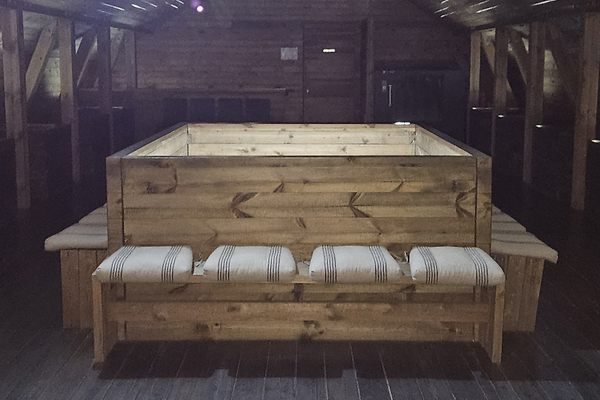Born in 1900, Žanis Lipke fought for Latvian independence following World War I before marrying his wife Johanna Novicka and starting a family in western Riga and taking up work as a stevedore and dock worker at the local port. However, Lipke also had strong left-leaning political inclinations and became involved in subversive activities against the government in 1934, although he was never jailed.
When German forces invaded Latvia in 1941, Lipke ended up working in warehouses near the Jewish ghetto, which included transporting Jewish workers between the ghetto and the warehouses. He used this arrangement to start smuggling Jews out of the ghetto and to freedom. While he initially used various hiding places around the city as well as his own house, he eventually decided in January 1942 to dig an underground shelter next to his own house where Jewish refugees could hide. When the first shelter collapsed in the spring, he built a new one using better construction techniques that could hold up to 12 people at a time. Lipke’s entire family kept the shelter secret and worked to help the Jews escape.
After the Soviet Union reoccupied Latvia in 1944, Lipke was interrogated repeatedly about his activities, but after a sharply worded comment about how the Communists were treating him, he was left alone. The bunker would cease to be used and was eventually demolished. Lipke would die after several heart attacks in 1987, and his wife would pass away in 1990.
In 2005, the film director Augusts Sukuts, Žanis Lipke’s daughter-in-law Ārija Lipke, and the entrepreneur Māris Gaili formed a non-governmental organization to construct a building at the location of Žanis and Johanna Lipke’s house that would serve as both a museum and a memorial. The museum, which opened in 2012, is truly unusual.
The building is a two story brown-black wooden structure where most of the rooms have no windows. Visitors access the museum by ringing a doorbell at the main entrance and then waiting for the door to be remotely unlocked, after which they then walking through a dark hallway into the main building’s reception hall. After getting an audioguide from staff, visitors can then explore the three floors of the building.
The darkly lit top floor of the museum, which is the central exhibit, features a single room with a shaft in its center and display cases lining the sides of the room. The shaft leads down into a room in the basement that contains a replica of the subterranean room that Lipke built for the Jewish refugees. Projected onto the floor of this basement room is a looping video recording of an interview with Johanna Lipke created months before she passed away describing how she and her husband worked to save Jews from the Holocaust. The display cases show the historic items belonging to the Lipke family as well as documentation from the Jewish people saved by the family. One of the most notable items is a drawing by the youngest Lipke child, Zigfrīds, depicting the bunker, which is the only surviving visual record of what the original bunker looked like.
The ground floor of the museum features a place where people can look into the shaft extending from the top floor to the basement and a lounge area with windows and a door leading to the exit. The basement contains virtual reality helmets that recreate the bunker space as well as a room with special exhibits. Note that it is not possible to actually enter the reconstructed bunker itself.
Overall, the dark, spartan interior of the wooden building and the recording of Johanna Lipke playing in the background make this museum a truly haunting place that replicates the atmosphere of the shelter where Jewish people fleeing the holocaust once hid decades ago.


